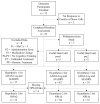Cognitive and Neuropsychiatric Effects of 40 Hz tACS Simultaneously with Cognitive Exercises for Dementia: A Randomized, Crossover, Double-Blind, Sham-Controlled Study
- PMID: 40283048
- PMCID: PMC12029112
- DOI: 10.3390/medicina61040757
Cognitive and Neuropsychiatric Effects of 40 Hz tACS Simultaneously with Cognitive Exercises for Dementia: A Randomized, Crossover, Double-Blind, Sham-Controlled Study
Abstract
Background and Objectives: Transcranial alternating current stimulation (tACS) at 40 Hz has shown potential to enhance cognitive function. However, research on its combination with cognitive exercises, particularly its long-term effects in a dementia population, remains limited. This study investigated the effects of 40 Hz tACS paired with simultaneous cognitive exercises on cognition, neuropsychiatric symptoms, and the depression status of individuals with dementia in a sham-controlled, double-blind crossover design. Materials and Methods: A total of 42 participants with dementia were randomized into two groups: (1) the R1S2 group received 40 Hz real tACS with cognitive exercises, followed by a ≥8-week washout period, and then sham tACS with cognitive exercises; (2) the S1R2 group received the reversed sequence. tACS was applied at 1.5 mA peak-to-peak with electrodes over the left dorsolateral prefrontal cortex and contralateral supraorbital area. Participants received two 30 min stimulation sessions per day, 5 days per week, for 4 consecutive weeks, paired with cognitive exercises using the MindTriggers app (2.9.1). The primary outcome was the Alzheimer's Disease Assessment Scale-Cognitive Subscale (ADAS-Cog) and the secondary outcomes included the Montgomery-Åsberg Depression Rating Scale (MADRS) and the Neuropsychiatric Inventory Questionnaire (NPI-Q). All outcome measures were assessed before and after each treatment block. Results: Real tACS paired with cognitive exercises significantly improved ADAS-Cog scores post-treatment compared to pre-treatment (p-value = 0.019), whereas sham tACS did not. Furthermore, real tACS produced significant long-term improvements approximately 2-3 months post-treatment in ADAS-Cog scores compared to sham (p-value = 0.048). Both real (p-value = 0.003) and sham (p-value = 0.015) tACS significantly reduced NPI-Q scores post-treatment. MADRS scores significantly improved (p-value = 0.007) post-treatment for real tACS but not sham. Conclusions: The 40 Hz tACS paired with cognitive exercises improves cognition, neuropsychiatric symptoms, and depression post-treatment in dementia, with sustained cognitive effects. The findings highlight its potential as a non-invasive therapeutic intervention for dementia.
Keywords: ADAS-Cog; clinical trial; cognitive exercise; crossover; dementia; neuromodulation; non-invasive brain stimulation; transcranial alternating current stimulation (tACS).
Conflict of interest statement
The authors declare no conflicts of interest. The funders had no role in the design of the study; in the collection, analyses, or interpretation of data; in the writing of the manuscript; or in the decision to publish the results.
Figures




Similar articles
-
TRanscranial AlterNating current stimulation FOR patients with mild Alzheimer's Disease (TRANSFORM-AD): a randomized controlled clinical trial.Alzheimers Res Ther. 2024 Sep 12;16(1):203. doi: 10.1186/s13195-024-01570-0. Alzheimers Res Ther. 2024. PMID: 39267112 Free PMC article. Clinical Trial.
-
Double-blind, randomized pilot clinical trial targeting alpha oscillations with transcranial alternating current stimulation (tACS) for the treatment of major depressive disorder (MDD).Transl Psychiatry. 2019 Mar 5;9(1):106. doi: 10.1038/s41398-019-0439-0. Transl Psychiatry. 2019. PMID: 30837453 Free PMC article. Clinical Trial.
-
A Novel Program to Improve Cognitive Function in Individuals With Dementia Using Transcranial Alternating Current Stimulation (tACS) and Tutored Cognitive Exercises.Front Aging. 2021 Mar 12;2:632545. doi: 10.3389/fragi.2021.632545. eCollection 2021. Front Aging. 2021. PMID: 35822057 Free PMC article.
-
Cognitive and Neuropathophysiological Outcomes of Gamma-tACS in Dementia: A Systematic Review.Neuropsychol Rev. 2024 Mar;34(1):338-361. doi: 10.1007/s11065-023-09589-0. Epub 2023 Mar 6. Neuropsychol Rev. 2024. PMID: 36877327 Free PMC article.
-
Neuroplastic effects of transcranial alternating current stimulation (tACS): from mechanisms to clinical trials.Front Hum Neurosci. 2025 Mar 12;19:1548478. doi: 10.3389/fnhum.2025.1548478. eCollection 2025. Front Hum Neurosci. 2025. PMID: 40144589 Free PMC article. Review.
References
-
- WHO . Global Action Plan on the Public Health Response to Dementia 2017–2025. World Health Organization; Geneva, Switzerland: 2017.
-
- WHO Dementia. [(accessed on 20 January 2025)]. Available online: https://www.who.int/news-room/fact-sheets/detail/dementia.
-
- Nissim N.R., Pham D.V.H., Poddar T., Blutt E., Hamilton R.H. The impact of gamma transcranial alternating current stimulation (tACS) on cognitive and memory processes in patients with mild cognitive impairment or Alzheimer’s disease: A literature review. Brain Stimul. 2023;16:748–755. doi: 10.1016/j.brs.2023.04.001. - DOI - PMC - PubMed
Publication types
MeSH terms
Grants and funding
LinkOut - more resources
Full Text Sources
Medical

